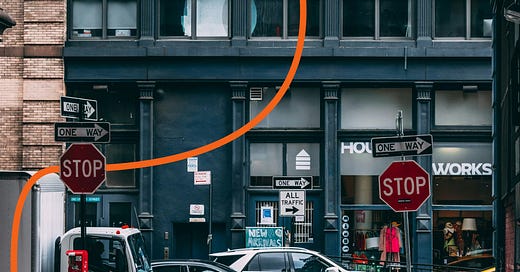The California Stop - Why You Need to Truly Hit the Brakes
We push through exhaustion, afraid of looking weak, uncommitted, or — worst of all — replaceable. The question is: where are your limits?
Ever heard of the California Stop?
We’ve all done it. You pull up to a stop sign, slow down juuuuust enough to make it look like you stopped, and then roll right through.
It’s called a California stop — and turns out, it’s exactly how most of us treat rest.
I used to think I was giving myself breaks. A long weekend here, a lazy Sunday there, and the best of the best: remote work trip to “reset” (I mean, it was fun, but calling it a “reset”? Oh, Honey). Well. Looking back, those weren’t real stops. They were just pauses — California stops — where I slowed down for a second before diving right back into the rush.
The "I’ll Just Push Through" Myth
Most of us have been conditioned to believe that our workplace will collapse without us. That if we step away for even a second, emails will pile up, projects will crumble, and our absence will trigger a full-blown apocalypse (I REALLY can’t stop laughing right now).
Let’s be real — if you left your job today, your company would replace you real quick. Harsh? Maybe. True? Absolutely.
Yet, despite knowing this, we push through exhaustion, afraid of looking weak, uncommitted, or — worst of all — replaceable. But here’s a truth bomb: your worth is not tied to how much you can endure before breaking.
Burnout Doesn’t Happen Overnight
Burnout creeps in slowly, like an app running in the background, draining your battery without you noticing. One skipped lunch break turns into five. A late-night email turns into a nightly routine. Soon, your body is waving red flags like fatigue, brain fog, headaches (or serious weekend-long migraines in my case) — but instead of stopping, you just… slow down a little.
A single day off won’t fix this. A weekend getaway won’t either. True recovery requires a full stop — not a California stop.
What Does a Real Stop Look Like?
Now I can confidently say: actually stopping was the best decision I could have made. Not just because I needed a breather, but because it gave me a chance to reorganise my life.
A real stop is intentional. It’s giving yourself permission to actually rest, without guilt, without checking Slack, without “just quickly responding to this one thing.”
It might be a few weeks off (I depends of course on how much you can take, but if you do it, remember, you’re dead for your company, OK? 😉 Even one full week is great, but if you have a space for two or more - even better).
It might be a sabbatical. An extended paid or unpaid break offered by some companies as a benefit, but let’s be real - it rarely happens (I was offered with mine only when I was about to leave).
But most of all: It might be as simple as reorganising your work-life situation so that rest isn’t a luxury, but a non-negotiable part of your life.
The Guilt Trap
How do I deal with the guilt of stepping away to recover from burnout?
You don’t deal with guilt — you stop.
Because if you’re focused on how to manage guilt, you’re not focusing on actually recovering. Guilt isn’t a sign that you’re doing something wrong; it’s just a byproduct of a culture that glorifies overwork. And it fades when you truly give yourself permission to heal.
I, for one, had time to rethink my values. To discover what I truly enjoy and what I don’t. I finally gave myself the space to fully commit to my personal growth — without the guilt, without the rush. I worked with my therapist in a way I never could before, without feeling like I was squeezing sessions between meetings.
I have tones of notes from our sessions and even more breakthroughs.
I found incredible mentors and immersed myself in learning about mindset. I finally started investing, something I had always wanted to do.
I traveled — really traveled — to places that had been on my list for years. I travel a lot, but I meant also the places I could visit not worrying about the time difference, you feel me, right?
I finally felt present.
No more half-assing my own self-improvement because I was too busy trying to do everything at once.
And just to be clear. I know taking a break like this is a privilege, and also the result of hard work. I had to manage my finances smartly to make it happen — this wasn’t just about stepping away, it was about planning ahead to even have that option on the table.
So, Are You Really Stopping, or Just Slowing Down?
Burnout isn’t solved with a quick “mental health day.”
And again - I am referring to an extreme situation.
Burnout isn’t just being tired or having a rough week — it’s a full-body, full-mind shutdown. It’s when exhaustion isn’t fixed by a good night’s sleep, when even small tasks feel impossible, and when the work you once enjoyed starts to feel like a weight you can’t lift. It builds up over time, fueled by stress, overcommitment, and the belief that pushing through is the only option — until one day, you just can’t.
To reset from that, you just can’t do another California stop (I love, love, love that expression now!🔥). From my experience: you have to come to a full stop. Let your body and mind reset.
Rebuild, reimagine, reorganise maybe.
PS This entry was inspired by a Headspace meditation discussing a California stop (not an ad — but hey, Headspace people, just call me😉).







I've never heard the term 'California stop,' but it perfectly captures the dark side of hustle culture. What a wonderful read.